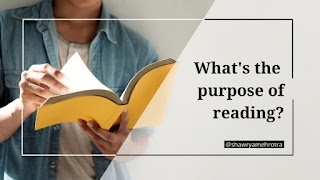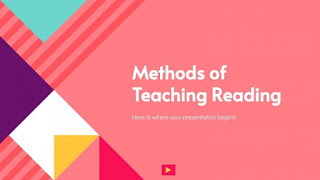- Get link
- X
- Other Apps
- Get link
- X
- Other Apps
Reading skills
A good reader lives a thousand lives before he dies
Reading
Speaking, Writing, and Listening skills, it is one among the four primary language learning skills. So, it is looking at a collection of written symbols and deriving meaning from them. When we read, our brains translate the written symbols/letters, punctuation, and spaces that our eyes see into words, sentences, and paragraphs that make sense to us. We can read aloud or silently (in our heads). Reading is a talent that allows us to receive information. But to enunciate the words we read; speaking is a necessary component of the difficult reading process. Reading is useful in this way since it allows us to both receive and sends information. Reading is also the capacity to recognize words in print (a process known as word recognition) and to infer meaning from them (a process called comprehension).
Purpose of reading
Reading has many purposes following them are:
v Read for enjoyment.
v For
knowledge.
v to
educate.
v To
instruct.
v As
a pastime.
v To
examine.
v To
finish a task.
v For
understanding.
Obstacles to Effective Reading
Some
of the important obstacles to effective reading are as follows:
Ø Lack of Grammatical Competence
Many people struggle to read efficiently because they cannot decipher the text's grammatical and lexical components. They are unable to distinguish between and identify the words, sentences, and expressions utilized in the text. It makes reading more difficult. If the reader cannot understand the text grammatically, he may stop reading.
Ø Lack of motivation
Motivation and discipline are needed to read for information and knowledge. Many people consider reading to be a tedious and time-consuming activity. A barrier to reading may be created by a lack of sufficient motivation and goals.
Ø Less Concentration
When reading, if the reader is not focused, he will simply turn page after page without much understanding. The psycholinguistic process of reading. The reader must pay close attention.
Ø Size of the Book
People typically like to read short articles and writings. The reader loses interest in a book if it has a large number of pages.
Ø Articulating the Words Loudly
Many readers have a habit of murmuring or articulating the text’s words aloud. They buzz each word, which makes it difficult to read quickly.
Ø Narrow Eye Span
Many
readers read the text with independent word-to-word eye movements. Their eyes
have a small range. It not only slows down reading but also has an impact on
understanding. decreased speed and comprehension when the attention span is
less. For readers to increase their eye span, adequate instruction and
approaches are necessary.
Techniques of Effective
Reading
Effective
reading strategies include the following:
v Highlighting Key Phrases
When
you later reread the text, this can be a helpful technique to help you remember
what you thought was significant. It's crucial not to overemphasize, though.
Consider reading a paragraph at a time, for instance, before underlining or
highlighting. This will make it possible for you to pick out its key points. As
an alternative, you might discover that it is helpful to read an entire chapter
first to gain a sense of the key concepts before going back and highlighting
the details that support the argument.
v Add
Notations to the Margin
If
you don't want to mark the book, you can use Post-it notes instead. You can do
this with both physical copies and electronic books (for example, if it is a
library book). This method makes it easier for you to interact with the
material, which increases the recall of what you read.
v Use the Signposts within
the Text Itself
Watch out for
words like "most importantly" and "critically." These emphasize
the themes that the author(s) thought were crucial.
Objectives/Goals of Reading
Reading to improve one's reading skills. Better readers always come from reading. Skimming, scanning, predicting, and reading for in-depth comprehension are all examples of reading skills. Through reading, these are refined.
Learn to think critically by reading. Critical thinking abilities help communication in all contexts. People must prioritise, come to conclusions, compare, draw inferences, and more to do everything from holding a phone conversation to developing a business plan. Reading can offer the opportunity to put these talents to use and hone them.
Strategies of Reading
Ø Using Prior Knowledge
Students
use what they already know to assist them to grasp the literature they are
about to read when they preview it. This gives any new information they read a
framework.
Ø Predicting
According
to their prior knowledge of related subjects, students' expectations are set
when they form predictions about the material they are about to read.
They
might mentally amend their forecast as they read in light of new information.
Ø Summarization and recognizing
the Main Idea
Students
must decide what is important and then summarize it in their own words to
identify the primary theme. Attempting to comprehend the author's motivation
for creating the material is implicit in this process.
Ø Questioning
Another
tactic for getting pupils to concentrate on the text's significance is asking
and responding to questions about it. Teachers can assist by demonstrating how
to ask effective questions and how to use the text to obtain the answers.
Ø Making Inferences
Students
must learn to draw from prior knowledge and spot cues in the text itself to
infer information that isn't expressed explicitly in the text.
Ø Visualizing
According
to studies, students who envision while reading retain information better than
those who do not (Pressley, 1977). When reading the text without illustrations,
readers can use the embedded illustrations or conjure up their images or
sketches in their minds.
Methods of Reading
v Survey
Look
over the content briefly before starting a new chapter to gain a sense of the
main points and concepts. The next procedure should take 5 to 10 minutes.
Go
through the introduction.
Pay
attention to the headings and subheadings.
Examine
the images, graphs, and charts (anything visual).
Read
the chapter synopsis.
Take
a look at the chapter's conclusion study questions.
v Questions
Your
reading should be guided by questions.
Before
reading the paragraphs in that part, make the first heading in the chapter into
a question. For example, read "What is a limited partnership?"
instead of "A Limited Partnership." Since you are now trying to find
the answer to the question, you have given reading a purpose.
v Read
Look
for the solutions to the questions you generated as you read. Use these reading
recommendations:
The
key idea is typically stated in the opening sentence of each paragraph.
To
make it easier for you to understand the author's point, look for transitional
terms like next, for instance, in contrast, and additionally.
As
you read, make notes in the margins or on a notepad. primary points and
concepts; Do not just regurgitate data from the textbook.
Just draw attention to the most crucial details. Too much emphasis might make distinguishing between the core idea and the supporting elements challenging.
v Recite
Examine
the questions you came up with or those at the end of the chapter when you've
finished reading.
Can
you respond to them? Unless you can, go back and review the relevant portions while making
notes.
Spend
some time reciting or remembering what you can.
As soon as you are done
reading, keep it in mind.
v Review
For
best comprehension and memory, it is crucial to revisit everything you learned
the day after you first learned it. If you don't study the material the next
day, you risk losing 80% of what you've learned.
Types of reading
Ø Skimming
Skimming,
also known as gist reading, is the process of reading a text quickly to get the
primary idea. Instead of pronouncing every word in this passage, the reader
concentrates on the fundamental idea or message of the text. Reading
periodicals or newspapers and looking up a name in a phone book are two
examples of skimming.
Ø Scanning
Here,
the reader skims through sentences to swiftly reach certain information. When scanning, the unnecessary text is rejected or ignored to focus
on finding a specific piece of information.
Ø Intensive Reading
Since
it requires the reader to pay close attention to every detail, intensive
reading takes much longer than skimming and scanning. It involves close reading
to improve understanding. Every word must be understood by the reader in this
passage.
Ø Extensive reading
A
lot of reading places less emphasis on correctness and more on flow. It
typically involves leisure reading and is more of an extracurricular activity.
It is quite unusual that readers will read material they dislike extensively.
For More Articles Check This...









Comments
Post a Comment